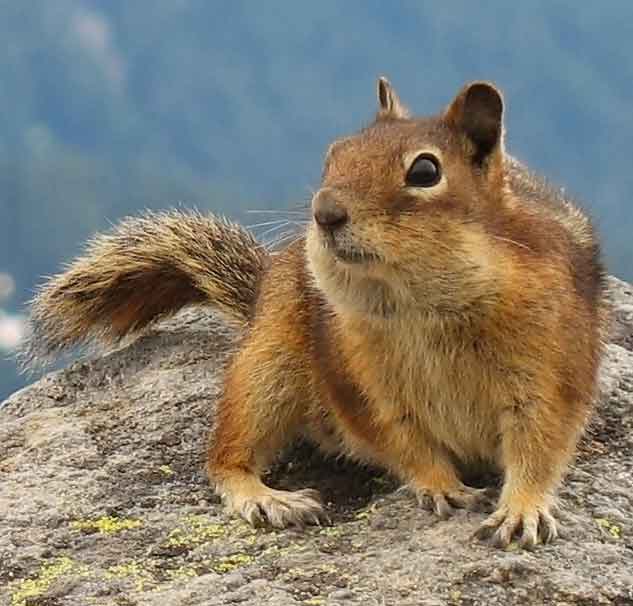
Callospermophilus lateralis (*)
Superregnum: Eukaryota
Cladus: Unikonta
Cladus: Opisthokonta
Cladus: Holozoa
Regnum: Animalia
Subregnum: Eumetazoa
Cladus: Bilateria
Cladus: Nephrozoa
Superphylum: Deuterostomia
Phylum: Chordata
Subphylum: Vertebrata
Infraphylum: Gnathostomata
Megaclassis: Osteichthyes
Cladus: Sarcopterygii
Cladus: Rhipidistia
Cladus: Tetrapodomorpha
Cladus: Eotetrapodiformes
Cladus: Elpistostegalia
Superclassis: Tetrapoda
Cladus: Reptiliomorpha
Cladus: Amniota
Cladus: Synapsida
Cladus: Eupelycosauria
Cladus: Sphenacodontia
Cladus: Sphenacodontoidea
Cladus: Therapsida
Cladus: Theriodontia
Subordo: Cynodontia
Infraordo: Eucynodontia
Cladus: Probainognathia
Cladus: Prozostrodontia
Cladus: Mammaliaformes
Classis: Mammalia
Subclassis: Trechnotheria
Infraclassis: Zatheria
Supercohors: Theria
Cohors: Eutheria
Infraclassis: Placentalia
Cladus: Boreoeutheria
Superordo: Euarchontoglires
Ordo: Rodentia
Subordo: Sciuromorpha
Familia: Sciuridae
Subfamilia: Xerinae
Tribus: Marmotini
Genus: Callospermophilus
Species: Callospermophilus lateralis
Subspecies: C. l. arizonensis – C. l. bernandinus – C. l. castanurus – C. l. certus – C. l. chrysodeirus – C. l. cinerascens – C. l. connectens – C. l. lateralis – C. l. mitratus – C. l. tescorum – C. l. trepidus – C. l. trinitatus – C. l. wortmani
Name
Callospermophilus lateralis (Say, 1823)
Type locality: near Cañon City. Restricted by Merriam (1905:163) to Arkansas River, about 26 mi. [42 km] below Canyon City, Fremont Co., Colorado (USA).
Synonyms
Citellus lateralis (Say, 1823)
Sciurus lateralis Say, 1823 (Original combination)
Spermophilus lateralis (Say, 1823)
References
Primary references
Say, T.. [Taxonomical footnotes]. In James, E.P. 1823. Account of an expedition from Pittsburgh to the Rocky Mountains, performed in the years 1819 and '20 : by order of the Hon. J.C. Calhoun, sec'y of war: under the command of Major Stephen H. Long. From the notes of Major Long, Mr. T. Say, and other gentlemen of the exploring party. H.C. Carey & I Lea. Philadelphia. 2: 1–442; i–xcviii. DOI: 10.5962/bhl.title.61116 BHL Reference page. : 46.
Helgen, K.M., Cole, F.R., Helgen, L.E. & Wilson, D.E. 2009. Generic Revision in the Holarctic Ground Squirrel Genus Spermophilus. Journal of Mammalogy 90(2): 270–305. DOI: 10.1644/07-MAMM-A-309.1 JSTOR PDF Reference page.
Links
Callospermophilus lateralis – Taxon details on Integrated Taxonomic Information System (ITIS).
Vernacular names
English: Golden-mantled ground squirrel
日本語: キンイロジリス
lietuvių: Auksaspalvis staras
The golden-mantled ground squirrel (Callospermophilus lateralis) is a ground squirrel native to western North America. It is distributed in the Rocky Mountains of British Columbia and Alberta, and through much of the western United States.[1]
Description
This ground squirrel is generally about 23 to 29 cm (9.1 to 11.4 in) in length. The weight range for adults is between 120 and 394 grams (0.26 to 0.86 lbs.)[2] It has whitish or yellow-gray underparts. The tail is brown to black with buff edges and a yellowish to reddish underside. It has pale rings around the eyes. The "mantle" across the shoulders is tawny to reddish, with males having a deeper reddish tinge. This species is distinguished from similar ground squirrels by a black-bordered white stripe down each side of the back.[3]
Some authors describe many subspecies of this taxon.[4]
Biology and ecology
Side view, Bryce Canyon, Utah
This species occurs in forests, chaparral, meadow margins, and sagebrush, especially in areas with many rocks or forest litter that provides shelter. It is associated with many kinds of coniferous trees, aspen, and manzanita.[3]
It is omnivorous, feeding on pine nuts, acorns, herbs and shrubs, fungi, many kinds of insects, eggs, young birds, lizards, carrion, and human foods when available.[3] This species caches food near its burrow, especially during the late summer and fall.[3] The squirrel has also been known to "beg" for human food at the wildlife urban interface.[5]
near Lake Almanor, California
This species hibernates over the winter. During the summers they gain extra weight in order to prepare for hibernation.[5] The squirrels hibernate in dens that can reach up to 100 feet in length although they are typically shallow in depth.[6] The breeding season commences when males and females emerge from hibernation in the spring. Most broods are born in July. A female has two to eight young per litter, with an average of five. There is no paternal care of the offspring. Juveniles resemble adults by 40 days of age. The life span of this ground squirrel is up to about seven years.[3]
Most adults are independent, rarely cooperating, and usually competing for resources. They may assemble at sites with abundant food but develop a group hierarchy. Adults reside alone in burrows, creating nests for hibernation or rearing of young. This species has been known to nest in structures, such as roofs.[3] This species becomes vocal when it feels threatened, making squeaking noises or growling. However, it is generally not a very vocal species.[5]
Predators of this squirrel include snakes, foxes, weasels, and bears.[1] It may carry the Rocky Mountain wood tick, a vector of Rocky Mountain spotted fever and other diseases.[1]
Conservation
This is a common and widespread species that is not considered to be threatened.[1]
References
Cassola, F. (2016). "Callospermophilus lateralis". IUCN Red List of Threatened Species. 2016: e.T42468A22265474. doi:10.2305/IUCN.UK.2016-3.RLTS.T42468A22265474.en. Retrieved 19 February 2022.
"Golden-Mantled Ground Squirrel - Facts, Diet, Habitat & Pictures on Animalia.bio". animalia.bio. Retrieved 2020-11-03.
Bartels, M. A. and D. P. Thompson. Spermophilus lateralis. Archived 2007-07-11 at the Wayback Machine In: Wilson, D. E. & D. M. Reeder (Eds). 2005. Mammal Species of the World. A Taxonomic and Geographic Reference (3rd ed.), Johns Hopkins University Press.
Callospermophilus lateralis. Integrated Taxonomic Information System (ITIS).
Evans, Adare (November 2016). "Golden-Mantled Ground Squirrel" (PDF). Wildlife Express (Idaho Fish and Game). 30.
Fraley, John (2018). "Golden-Mantled Ground Squirrel". Montana Outdoors.
Retrieved from "http://en.wikipedia.org/"
All text is available under the terms of the GNU Free Documentation License

